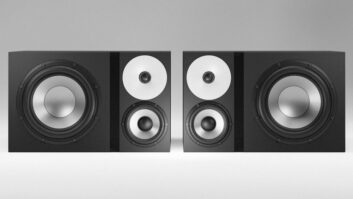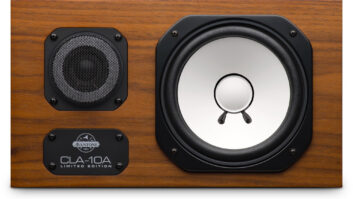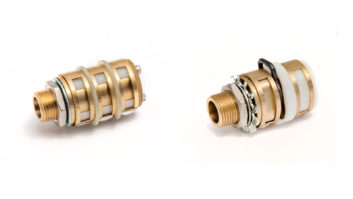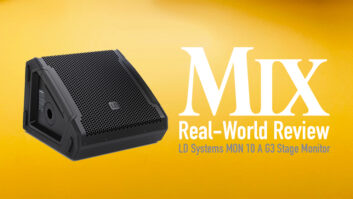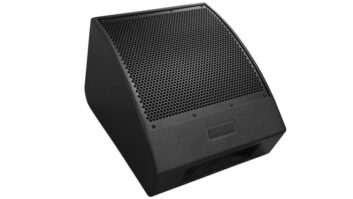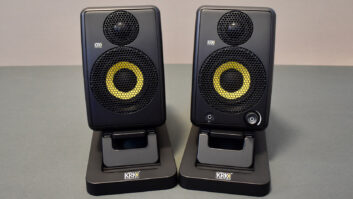PHYSICAL CHARACTERISTICSThe Fostex NF-1A active monitor’s enclosure is a two-way, bass reflex design with dual, flared elliptical ports. The enclosure is made up of 71/48-inch thick vinyl covered MDF on the sides, while the black painted baffle includes an additional 11/42-inch of thickness at the woofer. Transducers are recessed in the baffle and secured with wood screws. The interior sides and top of the cabinet are lined with 11/42-inch fiberglass, while the back and bottom each include “hyperbolic paraboloid” deflectors to damp standing waves and any internal back waves reflecting inside the enclosure. The amplifier compartment is isolated from the rest of the enclosure by the 71/48-inch thick MDF.
The visually impressive woofer design of this nearfield monitor blends new and old technology: The hyperbolic paraboloid cone design, which Fostex labels HP, is based on well-established structural engineering principles. Harry olson used these principles to design a similar complex-topology loudspeaker cone for the RCA LCA-1A studio monitor and JVC also introduced a speaker system using a similar woofer cone in the 1970s. Today, in order to minimize weight but retain tensile strength, soft drink companies manufacture plastic bottles with hyperbolic paraboloid bases. The HP cone offers extended bandwidth (no puckering on the extreme low frequencies and reduced breakup on the high end) and the cone and surround allow this transducer to operate well past 5 kHz.
The foam surround is also well thought out. Fostex calls it a “UDR” (up down roll) tangential edge, which comprises alternating up half roll, down half roll sectors, divided by a tangential wall. (Tangential crease or pleat surrounds have long been used on tweeter and compression driver diaphragms in order to minimize diaphragm rocking modes.) other key features on this cast aluminum frame woofer are double stacked flat 331/44-inch diameter spiders, a 111/42-inch diameter aluminum bobbin voice coil assembly and a vented pole piece. The conventional, ceramic magnet motor structure is magnetically shielded by a bucking magnet and shielding can. Terminations are 0.205-inch and 0.110-inch male tabs.
The faceplate to the Fostex tweeter is a black cast aluminum horn that loads the diaphragm by means of a wide dispersion waveguide. The 21mm soft dome is a “UFLC” (Urethane Film Laminated over Cloth) diaphragm, which is attached to a Kapton bobbin voice coil assembly. The conventional ceramic magnet motor structure is shielded with a bucking magnet. The T-yoke is topped off with a hemisphere of felt to absorb the back wave off of the diaphragm. Terminations are also 0.205-inch and 0.110-inch male tabs.
Powering the transducers are dual 60-watt amplifiers with a 6dB/octave, minimum-phase active crossover at 5 kHz. The power supply includes an oval, low-hum field transformer. Inputs can either be balanced (XLR) or unbalanced (11/44-inch). User controls include a continuously variable power input adjustment and a continuously variable tweeter level adjustment (+/-3dB). Three-way switches modify LF and HF output (+3dB, 0, -3dB) and there is also a mid frequency attenuator switch (-3 dB). For the measurements, all user controls were set to neutral or off.
ACOUSTICAL CHARACTERISTICSMeasurements on this system were made using a SYSid test system, Earthworks M30 microphone and Lab 101 mic preamp. The speaker was supported on a K&M 21300B Crank It Up speaker stand. our measurements showed that the frequency response of the Fostex NF-1A is not “flat,” despite its very low distortion measurements. From 200 to 2k Hz, the on-axis response rises 3 dB, with a narrow band valley centered at 750 Hz. From 2 to 3 kHz, the response falls off 4 dB, and then climbs 8 dB to around 7.5 kHz. After 7.5 kHz, the response falls off again by 4 dB up to 15 kHz. The 30Degrees off-axis response follows that of the on-axis until 1 kHz, where it falls 3-dB/octave to that of the on-axis. At 10 kHz, the off-axis response equals that of the on-axis then falls off sharply after that.
The impulse response shows decent alignment in time between tweeter and woofer, but not perfect. The decay is damped, but not smooth.
Now the good news. Besides the cone technology, the major highlight of this monitor is its very low distortion. The Fostex NF-1A studio monitor is the lowest distortion speaker we have tested to date. Above 50 Hz, the THD is less than 1%, with most of the spectrum under 0.5%. The multi-tone spectral contamination test looks at the system’s intermodulation and crossmodulation products (“self noise”). once again, the spectral contamination is the lowest we have ever tested, with the noise floor being around 60 dB down from the input tones.
The Fostex NF-1A has likely been designed to emulate commodity loudspeakers used in portable combo systems and is probably best suited to producing a reasonable impression of what mixed material will sound like in the real world. But with the judicious use of a parametric equalizer, the NF-1A can put out both a flat response and super clean sound.
